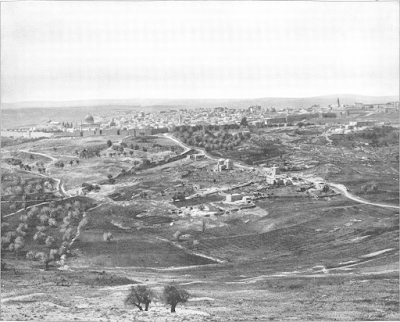
Jerusalem from Scopus
We have no means of knowing whether Joseph and Mary entered Jerusalem on their way to Bethlehem. They certainly passed in sight of the Holy City. Scopus, from which our view is taken, is to the north on the road from Nazareth to Bethlehem. We will assume that they saw Jerusalem from this point. It was not the same Jerusalem we saw for the last time, as we made our way to the north on May 2d, 1894, but Josephus has left on record a description of the city as it existed in the time of Herod, and it is possible for us to construct in imagination the city of that time.
The framework is the same to-day as it was in the year 5 B. C. The same hills are there: Zion, Moriah and Acra. The same valleys are there: Hinnom, Tyropeon and Jehoshphat. The Temple of Herod, which was eighty-three years in building, had been in course of erection for fourteen years. From Scopus where we are standing they could have seen the ground plan of the temple, within the same enclosure of thirty-five acres, where we now see in the distance the Mosque of Omar.
Source: Earthly Footsteps of The Man of Galilee, being three hundred and eighty-four... views and descriptions of the places connected with the earthly life of Our Lord and His Apostles ... By Bishop J.H. Vincent, etc. – 1894. This striking photographic journey throughout the Holy Land illustrated with no less than 384 b/w photographs taken in 1894 by R. E. M. Bain in order to document the expedition to Palestine headed by clergyman James Wideman Lee.
You can see that Jerusalem sits atop the mount, and the road leading up to it ascends. That is likely why the Psalms between Psalm 120-134 are named Psalms of Ascents. Though no one is quite positive about this, it is believed that these particular Psalms are gathered into a little hymnbook inside the larger body of Psalms because they were meant to be sung as the Israelites ascended the road to Jerusalem in advance of the several feasts and celebrations they were required to attend under the Law. The previous bunch of Psalms are called the Hallel Psalms, hallel meaning songs of praise, you can see we get the word hallelujah from hallel.
Phil Johnson explains it all here, in The Song of a Truly Blessed Man:
The position in the canon is significant, I think. They are grouped with Psalm 119 and the hallel Psalms. Most commentators nowadays believe these 15 psalms were sung by groups of pilgrims as they made their way to Jerusalem for those three pilgrim festivals—the same holy convocations where the Hallel psalms were sung.
So it's my conviction that the "Psalm[s] of Ascents" were songs for the journey. These are songs for pilgrims as they ascend to a higher place. You know that Jerusalem is situated on a high elevation. The Temple was built at the very top of Mount Zion, and the city itself was the highest populated place in Israel. So no matter where you were coming from, it was always up to Jerusalem. Every journey to Jerusalem was a pilgrimage to a higher place—and those annual pilgrimages therefore made a perfect metaphor for spiritual growth.
Whether your church is up a mount or down a valley or on even ground, sing praises as you look UP today to the highest of the High, the exalted and lifted up Jesus.
By common confession, the mystery of godliness is great: He appeared in the flesh, was vindicated by the Spirit, was seen by angels, was proclaimed among the nations, was believed in throughout the world, was taken up in glory. (1 Timothy 3:16)
May your Lord's Day be blessed.
